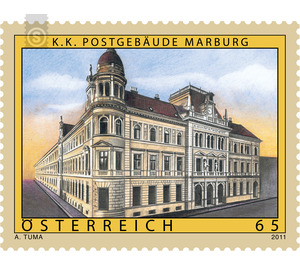Old Austria - Austria / II. Republic of Austria 2011 - 65 Euro Cent
Theme: Post & Philately
| Country | Austria / II. Republic of Austria |
| Issue Date | 2011 |
| Face Value | 65.00 |
| Edition Issued | 180,000 |
| Printing Type | offset |
| Stamp Type | Commemorative |
| Item Type | Stamp |
| Chronological Issue Number | 2242 |
| Chronological Chapter | OOS-OE2 |
| SID | 465774 |
| In 55 Wishlists | |
With the new value "Marburg", the popular brand series "Old Austria" now finds its attractive continuation; the motif designed by Prof. Adolf Tuma shows the historical K.K. Post Office of the city. Marburg (Slovenian "Maribor"), with about 120,000 inhabitants, the second largest city of Slovenia, is a Roman Catholic Archbishop's seat and since 1975 also the location of its own university. After all, Marburg's political affiliation with Austria (or the Holy Roman Empire or with Austria-Hungary) lasted from 1164 to 1918. Marburg goes on to mention a name first mentioned in 1164. " Markburg "back. In 1204 the place was called market and finally in 1254 as a city. Towards the end of the 15th century, the city was repeatedly besieged in vain by King Matthias Corvinus. The name Maribor was not created until the 19th century - as Slovenian national consciousness began - by a poet named Stanko Vraz. Until the end of the First World War (1918) remained Marburg as part of the Duchy of Styria and thus Austria -Hungary under the rule of the Habsburgs. During this war, presumed hostility to the state led to the forced internment of many Slovenes in Carinthia and Styria, leading to several violent conflicts between the German-speaking and Slovenian ethnic groups. During the dissolution of Austria-Hungary in the fall of 1918, both the newly-founded Republic of German-Austria and the new state of the Slovenes, Croats and Serbs claimed the city for themselves. Of course, the Slovenians living in the surrounding area were at an advantage, as the German-speaking settlement area of Styria, located in the north, was only 15 kilometers away. In November 1918, the K.K. Landsturm Commander Rudolf Maister finally became city commander and was promoted to general by the new Ljubljana government. The German-Austrian city politicians were deposed and the rapidly formed vigilantes had to give up after a short time - the subsequent regulation in the Treaty of Saint- Germain was thus already prematurely decided. After decades of change (Nazi period, Yugoslavia, etc.), Slovenia has been an independent state since 1991, but only joining the European Union, the introduction of the euro, and last but not least the Schengen Agreement gave the young state and thus Marburg a new lease of life. In the coming year, Maribor will even function as European Capital of Culture 2012.


